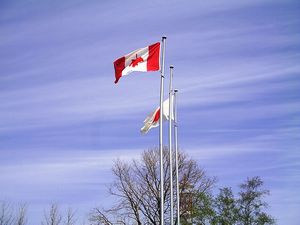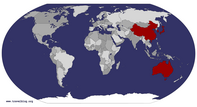Advertisement
Published: June 10th 2011

 Good intentions
Good intentions
They even got a flag, unluckily it wasn't put up rightIt happened at the beginning of May, the weather was getting warmer but still cold enough that you needed a jacket. The snow had melted, but I definitely wouldn't have called it spring if I hadn't known that technically it was. That's when they arrived. I knew about their arrival: I had been told to expect it. I just didn't know what to expect in the two months that followed their arrival.
There were seven of them in total, which I suppose isn't a large number, but when you're used to being one of the only ones, it seems like an infestation. This coupled with the special outings, special dinners, special classes, in short, special treatment that would take place while they were here, I was (I'm ashamed to admit) feeling a little bit of resentment towards them. I wanted special treatment, I was after all the one staying for a whole year! Who did they think they were anyway?
"They" turned out to be seven Canadian exchange students from a university in Novia Scotia, Canada. And the one and a half months they have been here so far have probably been the my best one and a half

 Izakaya dinner
Izakaya dinner
Eating out with some of the Canadiansmonths of Japan! It just goes to show that you shouldn't pre-judge anyone or anything, I've learnt my lesson.
The Canadians and I have fast become friends, I guess one of the reasons is that we can talk to each other effortlessly and without any communication problems, which is a nice change after a couple of months of hardly any English at all. I'm the littlest, tiniest bit glad that they aren't here for the whole year though as that would be very detrimental to my Japanese! Already I'm using English way more than I ever wanted to here, but I'm happy to make special considerations!
In fact one thing I've done to combat this sudden use of too much English was to enter myself into a speech contest that was held at the youth centre. I've really been trying to do things here that I couldn't or wouldn't have done back home and this is definitely one of them. I hate public speaking, but I vowed to at least try to get over some of my shyness whilst I was in Japan and what better way than to stand in front of a group of strangers and

 Speech contest
Speech contest
Overcoming my feartalk in another language in which you aren't fluent? Yeah, I couldn't think of a better one either. It was held last weekend and the topic was open, so I decided to talk about Australian 21st birthday parties. Which is quite a foreign concept to Japanese people. Recently it's been quite popular for people to have themed parties where we all have to dress up so I thought by including some pictures of me and my friends wearing ridiculous costumes might be entertaining for the audience (and take some of those eyes off me!). I was worried before the speech that my Japanese wouldn't be up to scratch because all the other students participating have been in Japan a lot longer and I assumed would have better Japanese, but once I started I didn't really think about it and just talked. After the contest a few Japanese people came up to me to say they had enjoyed my speech and that I sounded quite natural, I don't know whether they were just being polite or not, but I'll take the boost to my self-esteem anyway!
As I mentioned there are a lot of extra things going on at the

 Hakodate mountain
Hakodate mountain
Night view at the top of the mountainmoment because the Canadians are here, I have to take a few extra classes, and there are lots of outings that have been arranged for us too. The extra classes are actually quite interesting though, one of them in particular called 'Hakodate regional studies' which is really just a fancy name for school excursions, is my favourite. It's conducted by two teachers and a volunteer group of 4th year students who want to interact with some token foreigners. They teach us about Japanese history and culture and in particular that which is related to the city. We went to the top of Hakodate mountain and watched the sparkling lights of the city below us come to life as day turned to night. It was an unbelievably magical experience. It's supposed to be one of the best night views in Japan.
We've also learnt about the Japanese religion: Shinto, and went to a big shrine here called "Hachimangu". We were taught the correct procedure of how to purify yourself before entering and how to pray properly, in accordance to their customs. In contrast we were also taken to "Koryuji" which is a Buddhist temple. I found out that both of

 Hachimangu
Hachimangu
A Shinto shrine, Hakodatethese religions exist and are practiced (to some extent) side by side throughout Japan. In fact most Japanese people don't identify themselves as one or the other as would be the case in most other countries in the world, but actually combine the ideas of thought behind both of them almost into one religion of its own. For example, when a child is born they visit a Shinto shrine to celebrate and get blessings from the priest, when a child is 3, 5 and 7 they visit again, and also at the coming of age ceremony at the age of 20. However, when somebody dies they have a Buddhist funeral. Most festivals or "matsuri" are of Shinto origin but "Obon" (which is when people commemorate their dead relatives) is Buddhist. New Years traditions also contain a combination of both: on New Years Eve people go to a Buddhist temple to ring a bell 108 times to rid themselves of their sins from the previous year. Then during the first few days of January they visit a Shinto shrine to do "hatsumode", the first shrine visit of the new year. I find this extremely interesting.
The Canadians joined our calligraphy

 Ikebana
Ikebana
My attempt at a Japanese flower arrangementclass while they are here, so at long last I'm not the worst as I have an extra months practice compared to them. I didn't think I was making any progress but now I see that I am. We also do three other cultural classes: tea ceremony (with the same teacher I take lessons with); ikebana or flower arranging and koto lessons (koto is like a Japanese harp). All of these are very interesting, well I already take tea ceremony lessons but the extra practice as part of my studies is definitely beneficial and the flower arranging and koto are both completely new to me, and not so easy either. My goal is to be able to play "Sakura", a traditional song, on the koto without looking at the sheet and to be able to arrange some flowers so they don't just look like a 5 year old did it. A challenging goal I know, but I'm determined.
Apparently at Hokkaido University of Education it's common practice for first year students to take a trip together, in order to enhance the group togetherness of their year, a part of Japanese culture I have mentioned before. Since this trip coincided

 Onuma
Onuma
Surrounded by nature on our school tripwith the Canadians time in Hakodate, all the exchange students were invited along too. We went to a place called 'Neipal Mori' which is near Onuma, a few hours north of Hakodate in the mountains. It was a beautiful little place, the school had hired special dormitories and a sports centre, it was kind of like a camping trip. We participated in volleyball contests and even a "Park golf" contest. Park golf was a new experience for me too. It's sort of in between normal golf and mini golf, you use a big wooden stick that resembles those used for croquet and hit the ball into holes. It was fun, especially because I was the overall winner. Some may say beginners luck, but I say skill.
Neipal Mori also had an "onsen" (hot spring) and a "rotemburo" (outside hot spring), which was definitely another Japanese experience I wanted to partake in. I have to say I was a little apprehensive about it since it was my first time and, as seems to be the norm in Japan, you have to get naked surrounded by a bunch of other women. However, since I have had my share of communal nakedness

 Cherry blossoms
Cherry blossoms
In Goryokaku park, Hakodatein my dorm in Hakodate I got over that pretty fast, which I'm immeasurably thankful for because onsens are truly heavenly!
At the beginning of May I finally got to experience "hanami" and the undeniably beautiful sakura or cherry blossom trees. I'd heard a lot, naturally, as Japanese people can't seem to speak highly enough of these trees. I'd also seen pictures of them back in Australia, but now that I have seen them in person, I realise those pictures did them absolutely no justice. In Hakodate they come quite late in the spring as we are pretty far north, they can start as early as March down in Okinawa I think. And when they do come, it's fantastic! The most famous place to see them here is Goryokaku park, the star shaped fortress in the north of the city. The park is absolutely full of them and Japanese people gather under them drinking and eating with their friends, family and colleagues, which is the ancient practice of "hanami", literally flower viewing. Such a great experience! The two Chinese exchange students and I actually went on a day trip to Matsumae, a little town on the southern tip of

 Hanami
Hanami
Flower viewing in Goryokaku park, HakodateHokkaido. It's one of the top 100 best places to view the cherry blossoms in Japan so we really didn't want to miss it, especially since they bloom for such a short period of time. The trees are set amongst a beautiful garden and also surround a traditional Japanese castle, which was my first in Japan. It was absolutely beautiful!
In the last couple of months I've had so many "firsts", it's really been quite overwhelming, but at the same time it's one of the best parts of living overseas. I hope there are many more to come.
Advertisement
Tot: 0.103s; Tpl: 0.014s; cc: 9; qc: 49; dbt: 0.0585s; 1; m:domysql w:travelblog (10.17.0.13); sld: 1;
; mem: 1.2mb












